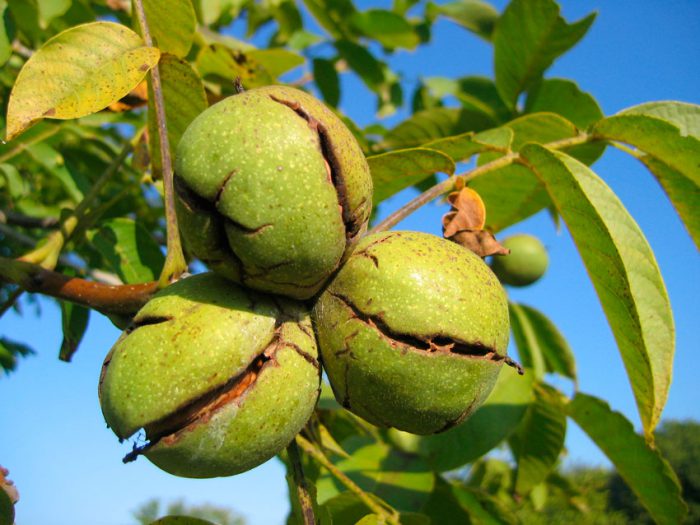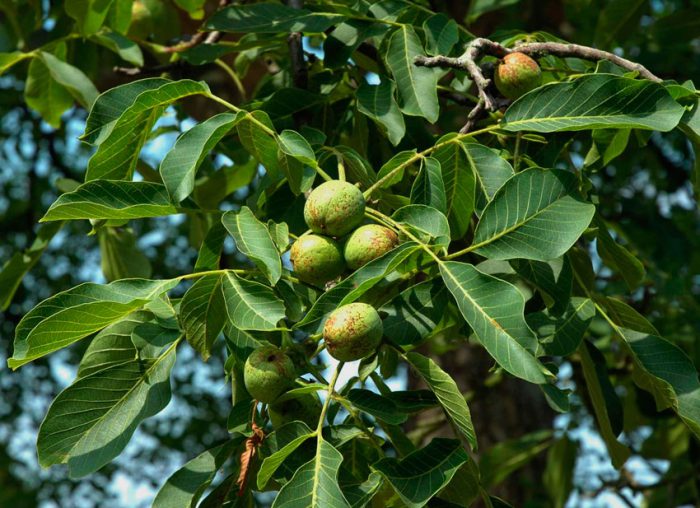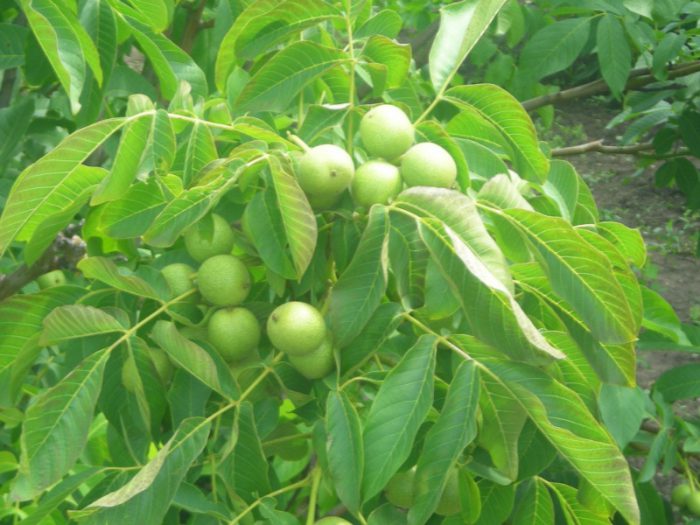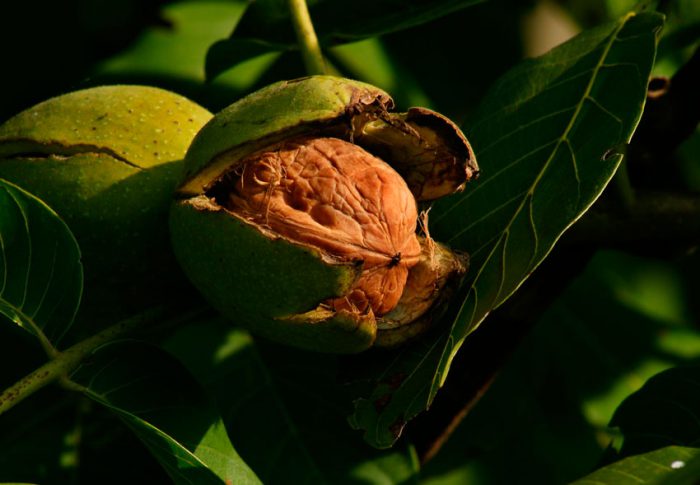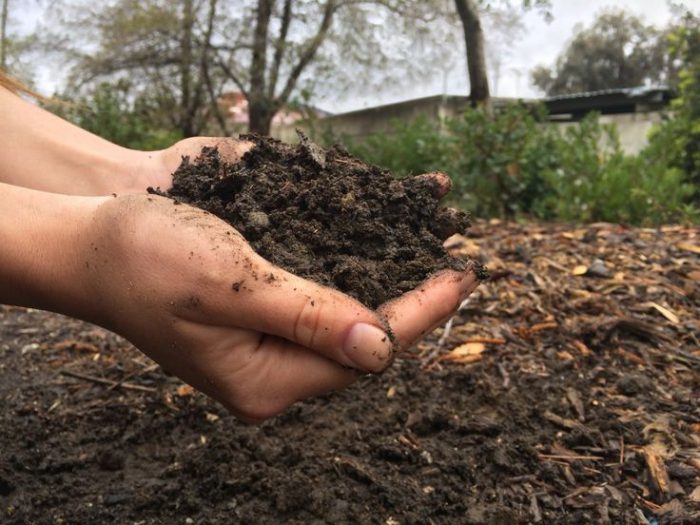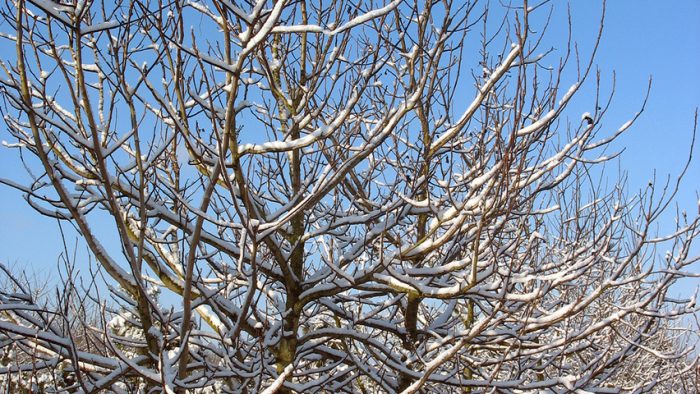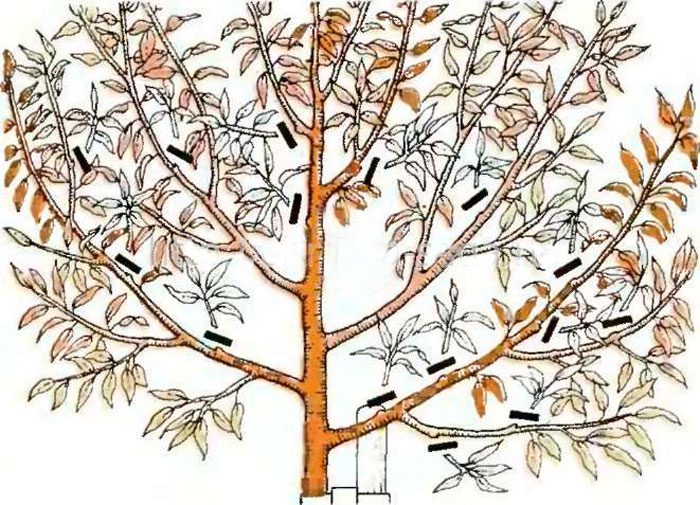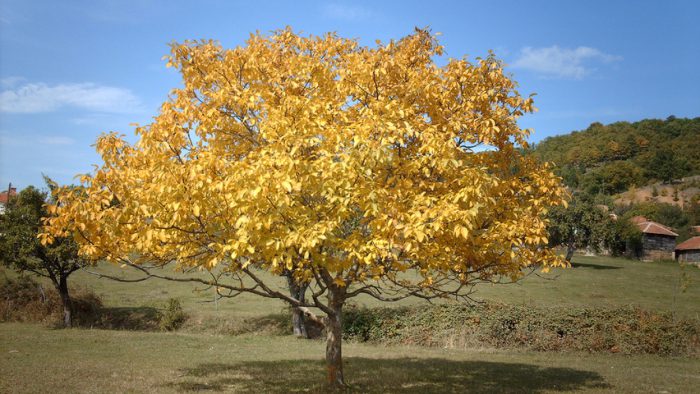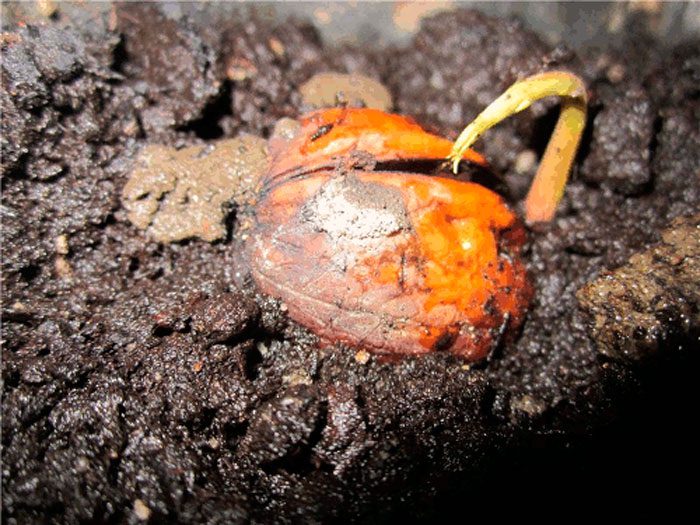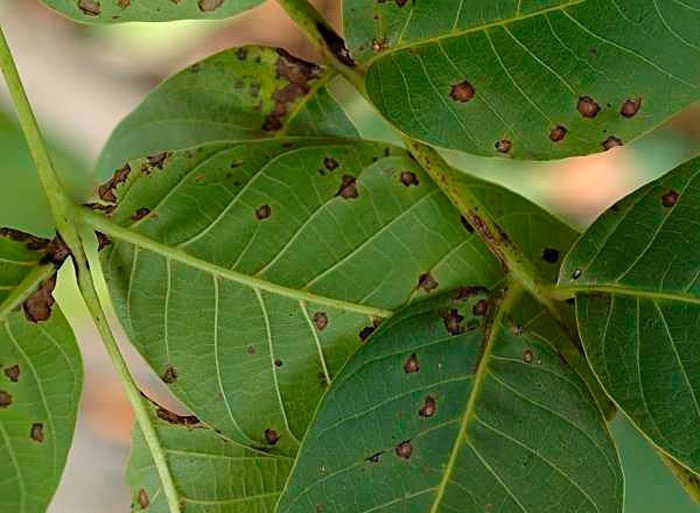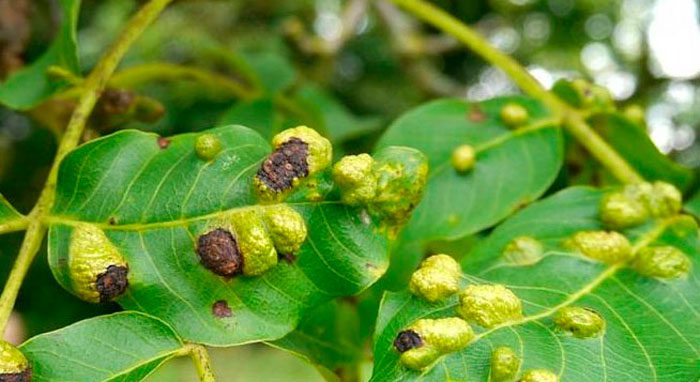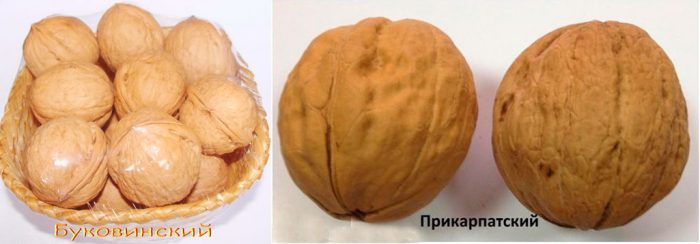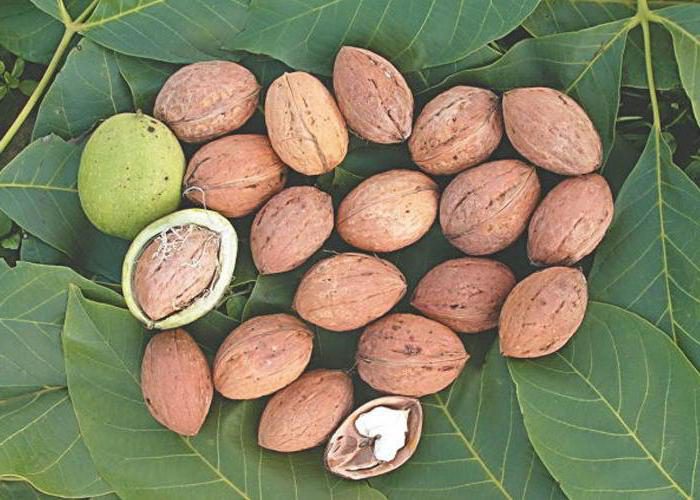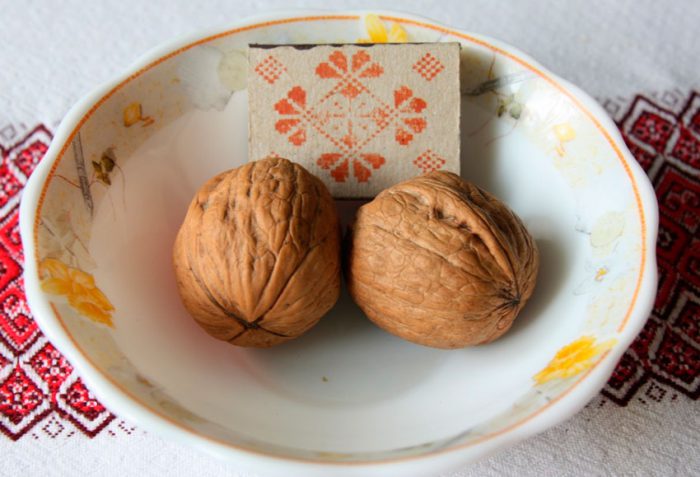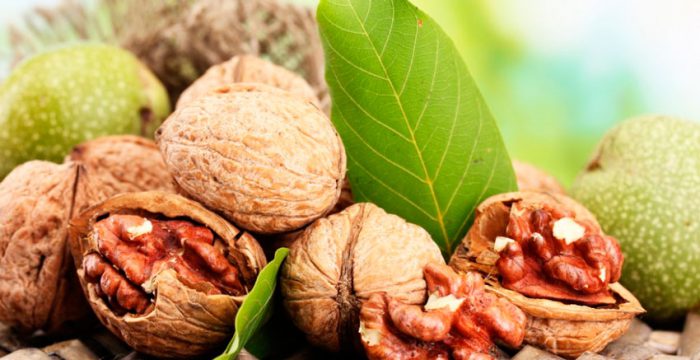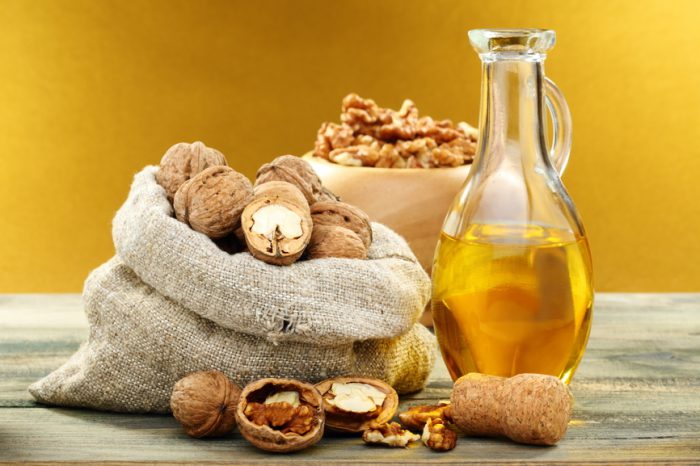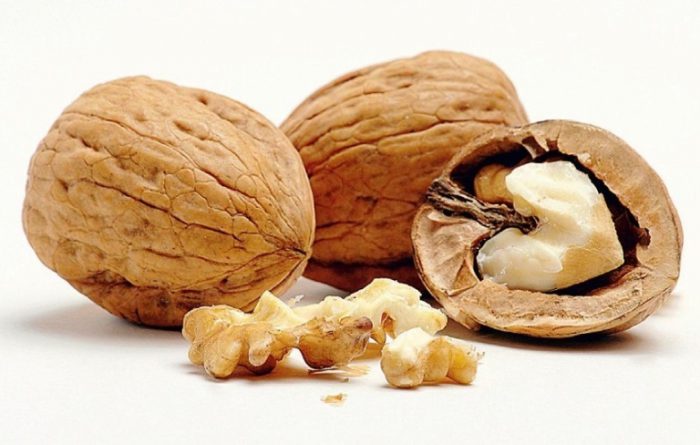Walnut tree (Juglans regia) - this species belongs to the genus walnut of the walnut family. Also, the walnut is also called royal, volosh or Greek. Under natural conditions, this plant is found in northern China, northern India, Asia Minor, Western Transcaucasia, Tien Shan and Greece. Several individual specimens can also be found in Norway. However, the largest specimens growing in natural conditions can be found in the southern part of Kyrgyzstan. It is believed that this plant comes from Iran, but there is an opinion that the homeland of the walnut may be India, China or Japan. For the first time about this tree was mentioned in the 7-5th century BC. So, Pliny writes that this plant was brought by the Greeks from the gardens of Cyrus, the king of Persia. When the culture brought from Greece ended up in Rome, it was already called "walnut". Later, this tree spread over the Swiss, Bulgarian, French and German territories. This culture came to America only in the first half of the 19th century. This tree was brought to the territory of Ukraine from Romania and Moldova under the name “Volosh walnut”.
Content
Walnut features
Such a tree has a relatively large size, its height can reach 25 meters, and the girth of its trunk can vary from 3 to 7 meters. The bark of the tree is gray in color, while the foliage and branches form a fairly large crown. The leaf plates of the plant are odd-pinnate, complex, consist of elongated leaflets, the length of which can be 4-7 centimeters. The buds open together with small flowers of a light green color in May. Flowers are pollinated by the wind. The same plant has both male and female flowers.The fruits of such a tree look like a single-seeded drupe with leathery rather thick pericarp and a spherical bone with incomplete partitions, the number of which varies from 3 to 5 pieces. The kernel of such a fruit can be eaten, and it is located inside the shell. Fruit weight varies from 5 to 17 grams.
This plant is not very hardy. So, it can die at a temperature of minus 25-28 degrees. Such a tree can live from 300 to 400 years. Walnut wood is directly related to valuable species, while it is often used by specialists to create expensive designer furniture. The foliage of this tree is used for the production of a dye for textiles. The main countries that produce walnuts currently include the USA, Iran, China, Turkey and Ukraine.
Below you will find information on how to properly plant and care for a walnut, on the rules for shaping its crown and fertilizers. Information will also be provided on how to deal with various diseases and harmful insects, as well as what varieties are best to choose for growing in a garden.
Planting a walnut

Most often, walnuts are recommended to be planted in open ground in the spring, but in the southern regions this procedure can be performed in the fall. If there is a good layer for drainage, then the composition of the soil can be absolutely anything. If the soil is clayey, it is recommended to add compost or peat to improve it. When choosing a place suitable for planting, it should be borne in mind that it must be well lit, since this tree loves light very much, and planting in a shaded place can lead to the death of the seedling. The richest harvest is given by those walnuts that stand alone in the sunniest place. It should also be noted that the groundwater at the landing site should not be located too close to the ground. The optimum acidity of the soil for a given plant is pH 5.5–5.8.
It should be remembered that the flowering of male and female flowers does not occur simultaneously. In this regard, it is very good if somewhere nearby (at a distance of 200-300 meters) a walnut of another variety grows. The wind will help the pollen to overcome such a considerable distance.
Before planting seedlings, they must be thoroughly examined. Roots and shoots on which there is rot, as well as dry and diseased ones, must be cut off. Then the root system must be immersed in a clay mash, the density of which should be like that of sour cream purchased in the store. In order to prepare a chatterbox, you need to mix water with 3 parts of clay and 1 part of rotted manure. If desired, you can pour into it a remedy that stimulates plant growth (Epin or Humate).
Spring planting
The planting hole should be prepared in the fall. It should be borne in mind that while the tree is young, it does not have a well-developed powerful root system, in this regard, it will take nutrients from the soil 1 m in diameter from the trunk. In this regard, special attention should be paid to creating suitable conditions for the growth and development of the walnut.
The size of the planting pit is influenced by the composition of the soil. On soils saturated with nutrients, the depth and diameter of the pit should be 0.6 meters. If the soil does not differ in its high fertility, then the required depth and diameter of the planting pit is 1 meter. When digging a hole, the top layer of soil saturated with nutrients must be removed to the side so that it does not mix with the bottom layer (it can be thrown out). Add humus (compost) and peat to the soil of the upper layer in a ratio of 1: 1: 1 and mix everything thoroughly. But at the same time, remember that fresh organic matter cannot be used.Then 0.8 kilograms of potassium chloride, 2.5 kilograms of superphosphate, 0.75 kilograms of dolomite flour and 1.5 kilograms of wood ash must be added to the same soil. Mix everything well. This amount of nutrients added to the soil during planting will feed the walnut for the first 3-5 years. During this time, the tree's root system will develop and grow so much that it will be able to extract the nutrients necessary for growth and development on its own.
The prepared planting hole must be filled up to the top with such an earth mixture, and then 15–20 liters of water must be poured into it.
During the winter period, the soil in the hole will settle and become more dense. In the spring, when you are going to plant a walnut, you will need to pull out the entire soil mixture from the planting pit. Then a support stake is driven into its bottom, the length of which should be 300 centimeters. After that, the soil mixture is poured into it with a mound so that when you install a seedling on it, its root collar rises above the soil surface by 3-5 centimeters. Then pour the remaining soil mixture into the hole, compact it well and pour 2-3 buckets of water over the plant. After the liquid has been absorbed, the soil will settle and the root collar will be at the same level with the ground, it is necessary to tie the tree to the support, and then sprinkle the surface of the trunk circle with a layer of mulch (sawdust, peat or straw), while its thickness should be from 2 up to 3 centimeters. Having departed from the trunk of the tree from 30 to 50 centimeters, it is necessary to make a roller out of the ground mixed with humus (3: 1), so that water collects inside it during rain. The roller should be about 15 centimeters high.
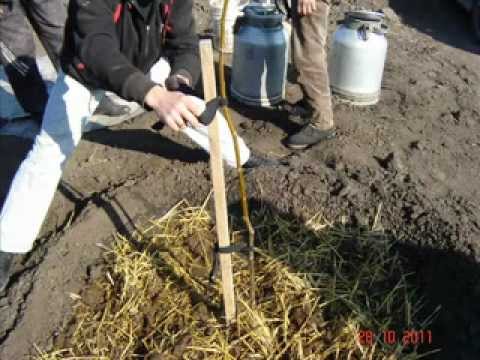

Watch this video on YouTube
Autumn planting
Planting walnuts in autumn and spring is practically the same. But in the fall, the hole should be prepared 14–20 days before planting. It must be remembered that in the fall such a tree can be planted only if the winters are mild and not frosty in the area.
Walnut care
Spring care
At the beginning of spring, you should start caring for plants in the garden. In the event that in the third decade of March the outside air temperature is above minus 4–5 degrees, it is recommended to make sanitary pruning of this plant, as well as to form its crown. In the event that it is impossible to trim the walnut at this time due to unfavorable weather conditions, it can be postponed. But it should be remembered that pruning can be done only before the start of sap flow.
This plant is quite hygrophilous. If the winter was with little snow, and in the spring there was very little rain, then the walnut will need water-charging irrigation. Clean the stem and skeletal branches from the bark that has died out, then they must be thoroughly rinsed using a solution of copper sulfate (3%). Then whiten the stem with lime. At the same time, it is necessary to treat the plant as a preventive measure against diseases and harmful insects. And at this time, seedlings are being planted.
In May, you should feed the tree. If the plant is adult, then it needs about 6 kilograms of ammonium nitrate per year. As a rule, this fertilizer is recommended to be applied to the soil in the spring, as well as at the beginning of the summer. Feeding trees should be started after they are 3 years old. The fact is that if the required amount of fertilizer was applied during planting, then the tree should be enough for about 3 years.
Summer care
If the summer period is hot and dry, then the walnut should be watered more often and abundantly. Starting from May until the end of July, such a tree should be watered once every 2 weeks. At the same time, it is not necessary to loosen the soil after watering, because such a plant reacts negatively to this procedure. In this case, the weeds must be removed.In summer, pests or fungi can settle on the tree. In this regard, it is necessary to carry out a systematic inspection of the plant, and if harmful insects or any of the diseases are found, then it will be necessary to treat the tree with appropriate insecticidal or fungicidal preparations.
In the last days of July, you need to pinch the upper part of the shoots, but only those whose growth you want to accelerate. It should be remembered that young shoots must be ripe at the time when frosts begin, otherwise they will simply freeze in winter. It is necessary to feed the walnut by the foliar method, for this it is necessary to use potassium and phosphate fertilizers, while trace elements should be added to them. There are varieties of walnuts whose fruits ripen in the last days of August, which means that you need to be ready for harvesting.
Autumn care
In most varieties of this plant, fruits are harvested in the autumn. The ripening time of fruits directly depends on the plant variety, and the collection of ripe fruits can be carried out from the end of August to the last days of October. After the nuts are harvested, the plant should be prepared for wintering. To do this, when all the leaves fall off, you need to make sanitary pruning, collect all fallen leaf plates and trimmed shoots, process the plant to destroy existing pests and pathogenic bacteria. Then you need to whiten the stem and the base of the skeletal cells, using lime for this. Young trees and seedlings need to be prepared for the onset of winter frosts.
Walnut processing
It is necessary to process walnuts for preventive purposes 2 times a year in order to prevent plant diseases or pest infestation. In the spring, the tree is treated very early, while the buds are not yet swollen. It, like the surface of the trunk circle, is treated with a solution of copper sulfate (1%) or Bordeaux liquid (1%). In autumn, the plant is treated with the same means, but only after all the leaves have fallen off, and the tree itself is at rest. You can replace these funds with a urea solution (7%), which is considered an insecticidal, fungicidal agent, and also contains a large amount of nitrogen. This tool is recommended to be used only during spring processing, because it is at this time that the tree needs nitrogen.
How to water
Walnut needs systematic watering, as it loves moisture very much. However, if it sometimes rains in spring and summer, then the tree need not be watered. If heat and drought are observed in summer and winter, then from May to the last days of July, the nut needs to be watered once every 2 weeks, 30-40 liters of water are taken per 1 square meter of the trunk circle. From the first days of August, all watering must be stopped. In the event that the autumn is dry, then the walnut will simply need moisture-charging podzimny watering, this will help him to better endure wintering.
Fertilizer
Walnut roots react negatively to soil loosening, in this regard, when applying complex mineral fertilizers, one must be very careful. Nitrogen fertilizers should be used in spring and early summer. If this fertilizer is applied later, then this can provoke the development of a fungal disease. Potash fertilizers and phosphates should be used for feeding in the autumn. A fruit-bearing tree requires 3 kilograms of potassium salt per season, 10 kilograms of superphosphate and ammonium sulfate each, and 6 kilograms of ammonium nitrate. You can also fertilize plants with green manure (peas, lupine, oats or rank). For this, in August, they are sown in the aisles of the nut, and in autumn they are plowed into the ground.
Walnut wintering
Walnut is very fond of warmth, in this regard, it can be grown only in areas characterized by mild, not frosty winters. But there are varieties that can withstand a short-term drop in air temperature to minus 30 degrees. Adult specimens do not need to be covered for the winter. However, this is simply necessary for seedlings and one-year-old trees, and they are covered with burlap. Their near-trunk circle is sprinkled with a layer of mulch (manure), while do not forget to step back 10 centimeters from the trunk.
Walnut pruning
What are the trimming times?
Formative and sanitary pruning of the tree should be done in spring (March or April), while the outside temperature should be above zero, but you need to be in time before the sap flow begins. There are gardeners who recommend pruning walnuts from the middle of summer, the fact is that in early spring, weak and frost-affected shoots are poorly distinguishable. In autumn, sanitary pruning is necessary, while dried, injured and diseased branches and shoots are removed.
Pruning rules
If the formative pruning is not done at all, then the tree may have a lot of defects, for example, breaking forks with fairly sharp corners, excessively long branches with a small number of lateral branches, and fruit-bearing shoots may also begin to die off as a result of the crown being thickened, and a large number of other problems may appear. The formation of the crown has a beneficial effect on the development of the walnut, thus increasing the yield and quality of the fruits themselves, and also regulating the growth of the plant.
In order to make any pruning, you need a very sharp knife or pruner, which must first be sterilized. The selected tool should make even cuts, while there should be no burrs. The first pruning is done after the tree is 150 centimeters tall. In this case, the height of the plant's trunk should be equal to 80 to 90 centimeters, and the crown - from 50 to 60 centimeters. When forming the crown, 10 skeletal branches should be selected, while the remaining shoots are cut off by 20 centimeters. The stem must be systematically freed from overgrowth. It takes 3 or 4 years to form the crown skeleton. After this is done, it is only necessary to periodically cut off competing and fattening shoots, as well as those that thicken the crown.
Spring pruning
In the spring, after the appropriate weather has been established, it is necessary to carry out sanitary pruning, while removing those branches and shoots that have dried out or damaged by disease or frost, as well as growing incorrectly. If the cut exceeds 0.7 millimeters, then it should be smeared with garden var. Both sanitary and formative pruning are performed at the same time.
In the event that pruning has not been done for a long time, then fruiting may well shift to the periphery. So, the fruits will be located only at the top of the crown. To correct this problem, rejuvenating pruning is performed. At the beginning of spring, it is necessary to remove excessively high skeletal branches with a saw. Then it is necessary to thin out the crown strongly enough in order to improve ventilation and increase the amount of incoming sunlight. It is necessary to cut the branches in the places of the lateral branches, as a result of which the young branches will grow sideways, and not up. After some time, due to the influx of tree sap, the buds will awaken, and young shoots will grow from them. So, over time, a new crown will form.
Autumn pruning
In the process of harvesting the fruits, in some cases, a branch or shoot may be injured or break off. Some of the shoots can be damaged by disease or harmful insects.In this regard, after all the leaves fall off, it will be necessary to cut off injured, sick, drying branches and shoots, as well as those that grow incorrectly. The fact is that in winter, the tree will consume the nutrients that it needs so much. After removing thick branches and shoots, the places of the cuts should be spread with garden varnish.
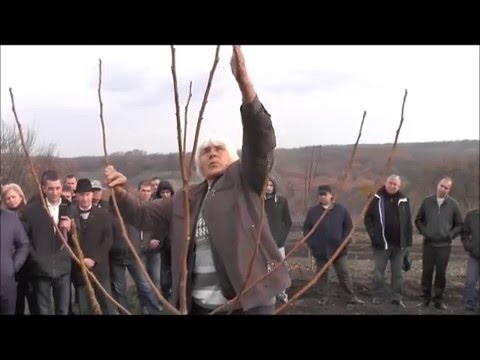

Watch this video on YouTube
Walnut propagation
Reproduction methods
This plant can be propagated by seeds, as well as by grafting. However, to inoculate a varietal cuttings, it is necessary to grow a stock from a seed. In this regard, it is necessary to know both methods of reproduction.
Propagation of walnut seeds
You should know that it takes a lot of time to grow a walnut from a seed. The seeds are recommended to be taken from a plant that is healthy, produces a rich harvest and grows in the same area where you live. Choose a fruit that is large enough so that the kernel can be removed without difficulty. The maturity of the nucleus can be judged by the state of the pericarp (pericarp). In the event that cracks appear on the pericarp, or by making an incision it is very easy to pull it out, then this indicates that the nucleus is ripe. It is necessary to remove the nut from the pericarp and place it outdoors in a sunny place, where it should dry for 7 days. After that, he is brought into a room, where the temperature should be in the range from 18 to 20 degrees, and they wait until he dries up. Planting the seed can be done this fall, or this procedure can be postponed until the onset of spring, but in this case, the nut will need stratification. To stratify the thick-skinned nut, it must be placed in a place with a temperature of 0-7 degrees for 90-100 days. If the shell has an average thickness or it is a thin-skinned variety, then the nut should be stratified at a temperature of 15 to 18 degrees for 4-6 weeks. For faster germination of stratified nuts, they are buried in moist sand and kept at a temperature of 15 to 18 degrees until they bite. Only then can the seed be planted in the soil. Seeds that have hatched are sown more rarely, and non-hatched seeds are sown denser. Sowing seeds in open ground is carried out only after the earth warms up to plus 10 degrees. Between the nuts in a row, leave 10 to 15 centimeters, and the row spacing should be about half a meter. Seeds that are medium in size must be embedded in the soil to a depth of 8 to 9 centimeters, larger seeds - from 10 to 11 centimeters. In the last days of April, the first seedlings appear. The germination rate of stratified seeds is 70 percent. After the plant grows 2 true leaf plates, it is transplanted to the school, while it is necessary to pinch the tip of the central root. The seedlings will stay in such a bed for a very long time. So, only after 2-3 years a high-quality stock will grow from the plant, and after 5-7 years it will turn into a seedling suitable for transplanting to a garden plot. In order to increase the growth rate of a seedling, it is grown in a greenhouse. Under such conditions, the stock will grow in just 12 months, and the seedling in 24 months.
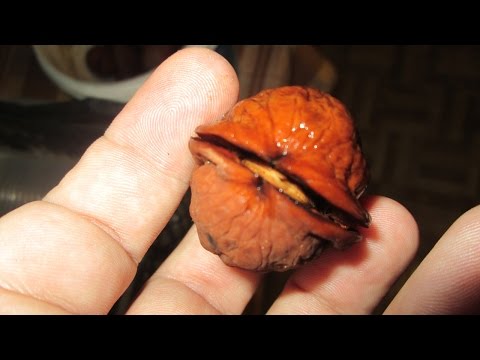

Watch this video on YouTube
Propagation of walnuts by grafting
The budding method is used to inoculate this plant. It should be noted that the buds of such a plant are quite large. In this regard, a shield should also have a large size, which is cut from the scion cuttings and inserted under the bark of the rootstock, since its task is also to feed the eye with water and nutrients. But there is one problem, even in areas with mild winters, buds that have taken root before the onset of the autumn period freeze out during wintering, since the culture is not hardy enough. In this regard, the budded seedlings with the onset of the autumn period must be dug up, but only after all the leaves have fallen off. They should be placed in a basement where the temperature should be around 0 degrees. The seedlings will stay there until the onset of spring.After the soil warms up to 10 degrees in spring, it will be necessary to plant the walnuts in the nursery. By the end of the growing season, their height can be from 1 to 1.5 meters, in which case it will be possible to transplant them to a permanent place.
Walnut diseases
Such a plant is highly resistant to both harmful insects and diseases, however, if the walnut is improperly looked after, then it may well get sick.
Walnut diseases:
Bacteriosis
Spots of black color appear on the leaf plates, as a result of which they begin to deform and die off. Infected fruits become of poor quality and most often fall unripe. Thick-skinned varieties are less susceptible to this disease. Bacteriosis can begin to develop due to nitrogen-containing fertilizers and prolonged rains. To destroy the disease, it is necessary to treat the plant with Bordeaux liquid, a solution of copper sulfate and another fungicidal agent. The tree should be processed in 2 stages. In autumn, it is imperative to collect and destroy the foliage that has fallen from the tree.
Brown spot (marsoniasis)
Brown specks appear on the surface of the leaf plates. They grow and gradually occupy the entire surface of the leaf. In an infected tree, the leaves begin to dry out and die off. Infected fruits also fall off without even ripening. This disease prefers wet weather. Infected foliage and stems should be cut off as the disease can spread to the entire plant. The reason for the development of marsoniasis can be incorrect, or rather, excessively frequent watering. You can cure a walnut with Strobi (4 grams of substance for a bucket of water) or Vectra (for a bucket of water from 2 to 3 grams of substance). The first time the plant is treated during the beginning of bud break, and the second - in the summer.
Root cancer
The root system of the plant suffers from this disease. The penetration of the pathogen occurs through cracks in the bark, as well as wounds, while convex growths are formed. With a strong development of root cancer, the walnut stops growing and bearing fruit, and in the most severe cases, it dries up and dies. The growths on the tree must be opened and thoroughly cleaned. After that, they are processed with a solution of caustic soda (1%). Then it is necessary to rinse the wound with running water directly from the hose.
Bacterial burn
Such a disease affects the leaf plates, buds, shoots, flowers and earrings of this plant. Initially, brownish-red spots are formed on young leaf plates, while depressed girdle spots of black color appear on the surface of the shoots. Infected leaves and shoots die after some time. The foliage and buds of the male inflorescences become dark and fall off. Black spots also appear on the surface of the pericarp. This disease is actively developing in rainy weather. Those parts of the tree that are infected should be cut and destroyed as soon as possible. Places of cuts must be treated with a solution of copper sulfate (1%). Walnuts must be treated with products containing copper.
Walnut pests
American white butterfly
This pest is especially dangerous, and it can settle on almost any fruit crop. During the period of intensive plant growth, the butterfly has time to develop in 2–3 generations. The first generation spoils the plants in July and August, the second in August, as well as in September, the third in September and also in October. Caterpillars of such an insect settle on shoots and destroy all leaf plates, using them as food. To destroy a butterfly, you need to burn those places in which there are many pupae and caterpillars.Then the plant is treated with a microbiological agent, for example: Lepidocide (25 grams per bucket of water), Dendrobacillin (30 grams per bucket of water) or Bitoxibacillin (50 grams per bucket of water). For one adult tree, from 2 to 4 liters of solution is used. However, it is worth remembering that you should not spray the nut during the flowering period.
Nut wart mite
Destroys young leaves without damaging the fruit. The appearance can be provoked by high humidity. When the insect settles on a tree, then dark brown tubercles will appear on its leaf plates. To exterminate it, acaricidal agents should be used, for example: Akarin, Aktara or Kleschevit.
Walnut (apple) moth
She feeds on the fruits of the plant. The insect crawls into the fruit and eats its kernel, as a result the nut falls off prematurely. During the season, the moth can give 2 generations, while the first damages the plant in May – June, and the second - in August – September. To prevent insect breeding on the plant, it is recommended to hang up pheromone traps that attract males. You should also destroy those fruits that have fallen, and the pest nests on the plant.
Walnut moth
Produces mines in foliage. Caterpillars eat away leaves from the inside, while their skin remains intact. On an infected nut, there are dark-colored tubercles on the surface of the leaf plates. An infected tree is treated with Lepidocide, if there are a lot of pests, then pyrethroids are used, for example: Decamethrin or Decis.
Aphid
Can live on any culture. It not only damages foliage, but also carries incurable viral diseases. When a tree is infected, you should immediately resort to using the most powerful drugs, for example: Antitlin, Aktellik or Biotlin.
Walnut varieties
Today there is a large number of varieties of this plant, which are distinguished by a relatively high resistance to harmful insects, diseases, and are also drought or frost-resistant. Most of these varieties give a rich harvest of high quality fruits. According to the ripening time, such plants are divided into early ripening - ripening occurs in the last days of August and in the first September, mid-ripening - from the second half to the last days of September, late-ripening - in the last days of September in early October. Specialists from various countries are working on the development of new varieties, for example, there are varieties of Ukrainian, Russian, Moldovan, American and Belarusian selection. The most popular varieties will be presented below.
Moldavian varieties
- Skinossky - an early variety, distinguished by winter hardiness and productivity. If the humidity of the air is increased for a long time, then the tree gets sick with brown spot. The egg-shaped fruits are large enough (about 12 grams). The thickness of the shell is medium, and the large kernel can be easily removed from the shell.
- Codrene - a late variety, characterized by frost resistance and productivity, resistant to marsoniasis and harmful insects. Large fruits have a thin, almost perfectly smooth shell. Cracking the shell is quite simple, while the kernel falls out in one piece or divided into 2 parts.
- Lunguece - is resistant to brown spot and frost. The oblong-oval fruits are large enough and have a smooth thin shell, which breaks quite easily, while the whole kernel is removed.
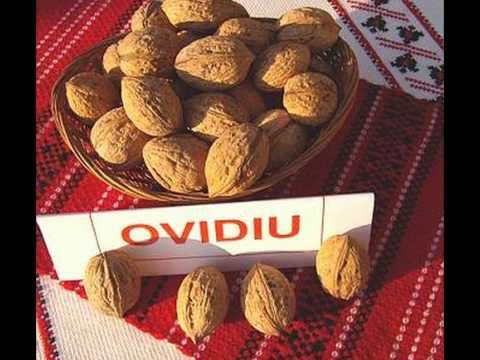

Watch this video on YouTube
In addition to these varieties of Moldovan selection, Kalarashsky, Korjeutsky, Kostyuzhinsky, Kishinevsky, Peschansky, Rechensky, Kogylnichanu, Kazaku, Brichansky, Faleshtsky, Yargarinsky and others are popular.
Ukrainian varieties
- Bukovinsky 1 and Bukovinsiky 2 is a mid-ripening and late-ripening variety with a high yield and resistance to marsoniosis. The shell is thin and strong, it just cracks, the whole core is separated.
- Carpathian Is a late-ripening variety with a stable yield and resistance to brown spotting. The shell is thin and strong, and the kernel is peeled off very easily.
- Transnistrian Is a mid-season variety with a consistently high yield, as well as frost resistance and high resistance to marsoniosis. The nut has an average size and weight of 11-13 grams. The shell is thin and strong, the core can be easily removed, since the internal partitions are quite thin.
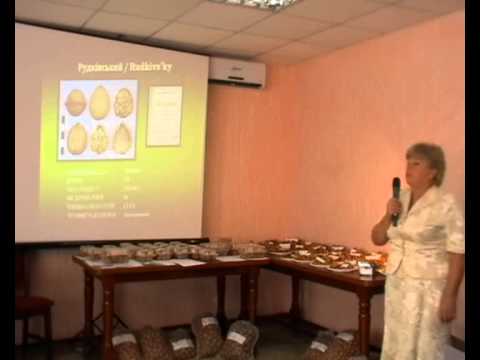

Watch this video on YouTube
Also, high-quality fruits and resistance to adverse weather conditions are available in such Ukrainian varieties as: Klyshkivsky, Bukovynska bomb, Toporivsky, Chernivtsky 1, Yarivsky and others.
The most popular Californian varieties, which are allocated in a separate group:
- Black california nut - the shell of large fruits is almost black in color, there are many convolutions on its surface.
- Santa Rosa Soft Shell - an early variety with a high yield. There are 2 varieties: the flowering of the first falls at the same time as the other varieties, and the second one half a month later than everyone else, after the threat of frost has passed. Medium-sized nuts have a thin white shell and a kernel of the same color, which is distinguished by high taste.
- Royal - This hybrid variety has a high yield. It is a cross between a black walnut from the US East and a California black walnut. Large fruits have a thick and strong shell, the kernel is very tasty.
- Paradox - a high-yielding variety. Large nuts have a tough, thick shell, and the kernels taste great.
Breeders are still breeding new hybrids, trying to get one that will have an even thinner shell.
Popular Russian and Soviet varieties
- Dessert - an early ripening variety with a high yield and drought tolerance. Can only be cultivated in the southern regions. The kernels are slightly sweet, tasty.
- Elegant - resistant to drought, harmful insects and diseases. Possesses average frost resistance. Medium fruits weigh about 12 grams and have slightly sweet kernels.
- Aurora - early ripening and mid-ripening variety. Winter-resistant, disease-resistant. The yield is increasing every year. The average weight of a nut is 12 grams.
Also popular are such varieties as Urozhainy and Izobilny.
Early ripening varieties are allocated in a special group. Such trees are not tall and they ripen very early from mid-August to early September. The tree has a moderate frost resistance and begins to bear fruit from the age of three. The most popular ones are:
- Dawn of the East - a low tree with a high yield, which can be grown in the middle lane.
- Breeder - such a high-yielding variety has low resistance to frost and high - to harmful insects and diseases. Medium sized nuts weigh about 7 grams.
Also popular are such varieties as: Pyatiletka, Petrosyan's Favorite, Baikonur, Pinsky, Pelan, Sovkhozny and Pamyat Minov.
The best and most common varieties include:
- Ideal - high resistance to frost. Its yield is the highest, because the tree bears fruit 2 times per season. The weight of the nuts is 10-15 grams. The kernels are very tasty, slightly sweet. It is possible to propagate only generatively, but at the same time the fruits can retain all the varietal characteristics of the parent plant.
- Giant - a high-yielding variety characterized by systematic fruiting. Fruit weight is about 12 grams. This variety can be cultivated in almost any region in Russia.
What are the benefits and harms of a walnut
The benefits of walnuts
Biologically active substances are found in any part of a walnut. For example, the bark contains triterpenoids, alkaloids, steroids, tannins, quinones and vitamin C. The foliage contains aldehydes, alkaloids, carotene, tannins, coumarins, flavonoids, anthocyanins, quinones, high aromatic hydrocarbons, phenol carboxylic acids, vitamins C, PP and essential oil. And in the tissues of the pericarp there is vitamin C, carotene, tannins, coumarins, quinones, phenolcarboxylic and organic acids.
Green nuts contain vitamins C, B1, B2, PP, carotene and quinones. Ripe fruits contain the same vitamins, as well as sitosterols, quinones, tannins and fatty oil, including linoleic, linolenic, oleic, palmitic acids, fiber, cobalt and iron salts.
In the walnut shell there are phenol carboxylic acids, coumarins, tannins. And in a thin brown skin, which is located on the surface of the fruit (pellicle), there are steroids, coumarins, tannins and phenol carboxylic acids.
The content of vitamin C in foliage becomes more and more during the season, while in the middle of summer it is maximum. Such leaves are valued for the high content of carotene and vitamin B1, and also for the dye juglone, which has an antibacterial effect. They also contain tannins.
Ripe nuts are high in calories and are considered highly active. There are 2 times more calories in them than in premium bread made from wheat flour. They can be used for prophylactic purposes against atherosclerosis, as well as if the body lacks cobalt salts, iron, and also vitamins. The fiber and oil in nuts can relieve constipation problems.
A decoction of the foliage is capable of healing wounds. It is used to treat rickets and scrofula. Infusion of foliage rinse the mouth for inflammatory diseases of the mouth and bleeding gums.
Means made from walnuts have an astringent, tonic, laxative, epithelial effect. They also have an antihelminthic, anti-sclerotic, anti-inflammatory effect, lower sugar, fight inflammation and stop bleeding.
Walnut oil is especially prized. It is highly nutritious and tastes good. It is recommended to take it during the recovery period for those who have suffered a very serious illness or surgery. It contains unsaturated fatty acids, vitamins, macro- and microelements, biologically active substances. It contains a very large amount of vitamin E, it has a beneficial effect on the body of an elderly person, especially if he suffers from hypertension, coronary heart disease, atherosclerosis, diabetes mellitus, chronic hepatitis, increased gastric acidity, thyroid hyperfunction. This oil also protects the human body from carcinogenic substances, improves radiation resistance, and also promotes the removal of radionuclides.
This oil has long been used to cure diseases such as tuberculosis, inflammatory diseases of the skin and mucous membranes, cracks, long-term non-healing ulcers, eczema, psoriasis, varicose veins and furunculosis.
At the University of California, scientists with the help of experiments were able to prove that after four weeks of eating such oil by a sick person, the amount of cholesterol in his blood ceased to rise and remained at the same level for many weeks. This oil is recommended for chronic arthritis, burns, ulcers, chronic colitis with constipation, diseases of the stomach and intestines. And it is also advised to take it to pregnant and breastfeeding women.
Contraindications
You can not eat walnuts and products with their content for those who have an individual intolerance to such a nut. In people suffering from neurodermatitis, psoriasis and eczema, such a nut and preparations with its content can cause an exacerbation of the disease, so their use should be under the supervision of a specialist. You can not eat such nuts for those who have increased blood clotting, bowel disease and pancreas. Eating too many walnuts can lead to severe head pain, swelling of the throat, and inflammation of the tonsils. A healthy person is recommended to eat 100 grams of such nuts per day.

